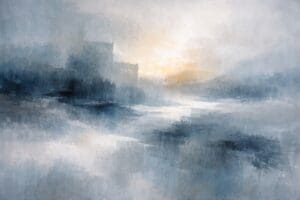Nature has long been a muse for artists, providing an endless array of colors, textures, and moods to capture on canvas. Oil painting, with its versatility and rich, vibrant results, is an ideal medium for depicting the beauty of landscapes. In this blog post, we’ll explore various techniques for painting landscapes in oil, tips for capturing the essence of nature, and the benefits of working en plein air. Whether you’re a seasoned artist or a beginner, these insights will help you bring the outdoors to life on your canvas.
The Allure of Nature in Art
Nature’s beauty is a powerful source of inspiration. The ever-changing light, the vast array of colors, and the intricate details of the natural world offer endless possibilities for artistic expression. Landscapes, in particular, allow artists to explore a wide range of elements—from the grandeur of mountains and forests to the tranquility of rivers and meadows.
Painting landscapes not only enhances your technical skills but also deepens your appreciation for the natural world. By observing and translating the nuances of nature, you learn to see the world more vividly and share that vision with others.
Techniques for Painting Landscapes in Oil
1. Understanding Light and Shadow
Light is a crucial element in landscape painting. It defines the time of day, the weather, and the overall mood of the scene. To capture light effectively:
- Observe the Light Source: Determine the direction of the light source and how it affects the landscape. Notice how light creates highlights and shadows.
- Use Value Studies: Create value sketches to understand the distribution of light and dark areas. This helps in establishing a strong composition.
- Layering: Start with a toned canvas and build up layers, beginning with dark tones and gradually adding mid-tones and highlights.
2. Color Harmony and Palette
Nature is a symphony of colors. To achieve harmony in your landscape paintings:
- Limited Palette: Start with a limited palette to maintain color harmony. A basic landscape palette might include colors like ultramarine blue, burnt sienna, cadmium yellow, and titanium white.
- Color Mixing: Practice mixing colors to achieve natural hues. For example, mixing blue and yellow for various greens and adding small amounts of complementary colors to mute tones.
- Temperature and Mood: Warm colors (reds, oranges) can bring warmth and energy, while cool colors (blues, greens) evoke calm and serenity. Use these to set the mood of your painting.
3. Capturing Texture and Details
Texture adds realism and interest to your landscape paintings:
- Brush Techniques: Use different brushstrokes to mimic textures found in nature. For example, use a fan brush for foliage, a palette knife for rough textures, and a soft brush for smooth areas.
- Impasto: Apply thick layers of paint to create a three-dimensional effect, simulating textures like tree bark or rocky surfaces.
- Detailing: Focus on key areas for detailed work while leaving other areas less defined. This directs the viewer’s attention and creates a sense of depth.
4. Composing the Landscape
A well-composed landscape draws the viewer’s eye and conveys the essence of the scene:
- Rule of Thirds: Divide your canvas into a 3×3 grid and place key elements along these lines or at their intersections to create a balanced composition.
- Leading Lines: Use natural lines in the landscape, such as rivers, paths, or tree branches, to guide the viewer’s eye through the painting.
- Foreground, Middleground, Background: Establish depth by including elements in the foreground, middleground, and background. This creates a sense of perspective and scale.
The Benefits of Painting En Plein Air
1. Direct Observation
Painting en plein air, or outdoors, allows you to observe the landscape firsthand. This direct observation helps you capture the true colors, light, and atmosphere of the scene more accurately than working from photographs.
2. Immersive Experience
Being in nature immerses you in the environment, providing a deeper connection to the subject. The sounds, smells, and tactile sensations enhance your overall experience and can influence your artistic interpretation.
3. Spontaneity and Freshness
Working outdoors encourages a more spontaneous and loose approach. The changing conditions force you to work quickly and make decisive choices, often resulting in a more dynamic and lively painting.
Tips for Painting En Plein Air
1. Preparation
- Pack Light: Bring only essential supplies—portable easel, a limited palette of paints, a few brushes, a palette knife, and canvas or panels.
- Weather-Ready: Dress appropriately for the weather and bring sunscreen, a hat, water, and snacks.
2. Simplify the Scene
- Focus on Key Elements: Choose a focal point and simplify the scene to avoid getting overwhelmed by details.
- Thumbnail Sketches: Start with quick sketches to establish composition and values before committing to the canvas.
3. Adapt to Changing Conditions
- Work Quickly: Light and shadows change rapidly, so work efficiently to capture the essence of the scene.
- Be Flexible: Be prepared to adjust your composition or color choices as the light and weather change.
4. Practice Patience
- Take Breaks: Step back periodically to assess your work and avoid getting too focused on one area.
- Enjoy the Process: Embrace the challenges and enjoy the experience of being outdoors.
Online Resources and Communities
For further learning and inspiration, explore these online resources and communities:
- WetCanvas: An online community for artists with forums, tutorials, and galleries.
- ArtStation: A platform for artists to showcase their work and connect with others.
- The Virtual Instructor: Offers tutorials and courses on various art techniques, including landscape painting.
- Artists Network: Provides articles, videos, and resources for artists of all levels.
Conclusion
Painting landscapes in oil is a rewarding endeavor that combines technical skill with a deep appreciation for nature. By understanding light, color, and composition, and by embracing the spontaneity of painting en plein air, you can create captivating works that capture the beauty and essence of the natural world. Whether you’re inspired by the serene beauty of a meadow or the dramatic majesty of mountains, the techniques and tips shared here will help you on your artistic journey. Happy painting!
For more tips, tutorials, and inspiration, follow us on Instagram and join our community of nature-loving artists.
By incorporating these techniques and embracing the practice of painting en plein air, you’ll not only enhance your artistic skills but also develop a deeper connection to the natural world. So, grab your easel, head outdoors, and let the beauty of nature inspire your next masterpiece.
*For collaborations, art features, or inquiries, please contact us at in**@**********rt.ie. Don’t forget to follow us on Instagram, Facebook, Twitter.
Disclaimer: The views and opinions expressed in this article do not necessarily reflect the official policy or position of Irish Artmart.
Irish Artmart – Your Gateway to Artistic Excellence.




